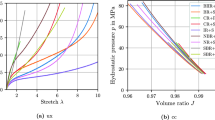Abstract
Explicit expressions of Mori-Tanaka’s tensor for a transversely isotropic fiber reinforced UD composite are presented. Closed-form formulae for the effective elastic properties of the composite are obtained. In a 3D sense, the resulting compliance tensor of the composite is symmetric. Nevertheless, the 2D compliance tensor based on a deteriorated Mori-Tanaka’s tensor is not symmetric. Nor is the compliance tensor defined upon a deteriorated 2D Eshelby’s tensor. The in-plane effective elastic properties given by those three approaches are different. A detailed comparison between the predicted results obtained from those approaches with experimental data available for a number of UD composites is made.
Similar content being viewed by others
References
Mori, T. and Tanaka, K., Average stress in matrix and average elastic energy of materials with misfitting inclusions. Acta Metallurgica, 1973, 21(5): 571–574.
Benveniste, Y., A new approach to the application of Mori-Tanaka’s theory in composite materials. Mechanics of Materials, 1987, 6(2): 147–157.
Eshelby, J.D., The Determination of the Elastic Field of an Ellipsoidal Inclusion, and Related Problems. Proceedings of the Royal Society of London Series A Mathematical and Physical Sciences, 1957, 241(1226): 376–396.
Tandon, G.P. and Weng, G.J., The effect of aspect ratio of inclusions on the elastic properties of unidirectionally aligned composites. Polymer Composites, 1984, 5(4): 327–333.
Tandon, G.P. and Weng, G.J., Stress Distribution in and Around Spheroidal Inclusions and Voids at Finite Concentration. Journal of Applied Mechanics, 1986, 53(3): 511–518.
Weng, G.J., Some elastic properties of reinforced solids, with special reference to isotropic ones containing spherical inclusions. International Journal of Engineering Science, 1984, 22(7): 845–856.
Wang, Y.M. and Weng, G.J., The influence of inclusion shape on the overall viscoelastic behavior of composites. Journal of Applied Mechanics, 1992, 59(3): 510–518.
Zhao, Y.H. and Weng, G.J., Effective elastic moduli of ribbon-reinforced composites. Journal of Applied Mechanics, 1990, 57(1): 158–167.
Zheng, Q.S. and Du, D.X., An explicit and universally applicable estimate for the effective properties of multiphase composites which accounts for inclusion distribution. Journal of the Mechanics and Physics of Solids, 2001, 49(11): 2765–2788.
Klusemann, B., Böhm, H.J. and Svendsen, B., Homogenization methods for multi-phase elastic composites with non-elliptical reinforcements: Comparisons and benchmarks. European Journal of Mechanics-A/Solids, 2012, 34(0): 21–37.
Kachanov M., Tsukrov I. and Shafiro B., Effective moduli of solids with cavities of various shapes. Applied Mechanics Reviews, 1994, 47(1S).
Eroshkin, O. and Tsukrov, I., On micromechanical modeling of particulate composites with inclusions of various shapes. International Journal of Solids and Structures, 2005, 42(2): 409–427.
Nogales, S. and Böhm, H.J., Modeling of the thermal conductivity and thermomechanical behavior of diamond reinforced composites. International Journal of Engineering Science, 2008, 46(6): 606–619.
Tandon, G.P. and Weng, G.J., Average stress in the matrix and effective moduli of randomly oriented composites. Composite Science Technology, 1986, 27(2): 111–132.
Zhao, Y., Tandon, G. and Weng, G., Elastic moduli for a class of porous materials. Acta Mechanica, 1989, 76(1): 105–131.
Gommers, B., Verpoest, I. and Van, H.P., The Mori—Tanaka method applied to textile composite materials. Acta Materialia, 1998, 46(6): 2223–2235.
Schjøt, T.J. and Pyrz, R., The Mori-Tanaka stiffness tensor: diagonal symmetry, complex fibre orientations and non-dilute volume fractions. Mechanics of Materials, 2001, 33(10): 531–544.
Benveniste, Y., Dvorak, G.J. and Chen, T., Stress fields in composites with coated inclusions. Mechanics of Materials, 1989, 7(4): 305–317.
Chen, T. and Dvorak, G.J. and Benveniste, Y., Stress fields in composites reinforced by coated cylindrically orthotropic fibers. Mechanics of Materials, 1990, 9(1): 17–32.
Liu, H. and Brinson, L.C., A hybrid numerical-analytical method for modeling the viscoelastic properties of polymer nanocomposites. Journal of Applied Mechanics, 2006, 73(5): 758–768.
Li, Y., Waas, A.M. and Arruda, E.M., A closed-form, hierarchical, multi-interphase model for composites— Derivation, verification and application to nanocomposites. Journal of the Mechanics and Physics of Solids, 2011, 59(1): 43–63.
Benveniste, Y., Dvorak, G.J. and Chen, T., On diagonal and elastic symmetry of the approximate effective stiffness tensor of heterogeneous media. Journal of the Mechanics and Physics of Solids, 1991, 39(7): 927–946.
Qiu, Y.P. and Weng, G.J., On the application of Mori-Tanaka’s theory involving transversely isotropic spheroidal inclusions. International Journal of Engineering Science, 1990, 28(11): 1121–1137.
Castañda, P.P. and Willis, J.R., The effect of spatial distribution on the effective behavior of composite materials and cracked media. Journal of the Mechanics and Physics of Solids, 1995, 43(12): 1919–1951.
Ferrari, M., Asymmetry and the high concentration limit of the Mori-Tanaka effective medium theory. Mechanics of Materials, 1991, 11(3): 251–256.
Berryman, J.G. and Berge, P.A., Critique of two explicit schemes for estimating elastic properties of multiphase composites. Mechanics of Materials, 1996, 22(2): 149–164.
Li, J.Y., On micromechanics approximation for the effective thermoelastic moduli of multi-phase composite materials. Mechanics of Materials, 1999, 31(2): 149–159.
Mura, T., Micromechanics of defects in solids, The Netherlands: Springer Company, 1987.
Huang, Z.M. and Zhou, Y.X., Strength of Fibrous Composites. Hangzhou, New York: Zhejiang University Press & Springer, 2011.
Soden, P.D., Hinton, M.J. and Kaddour, A.S., Lamina properties, lay-up configurations and loading conditions for a range of fibre-reinforced composite laminates. Composites Science Technology, 1998, 58(7): 1011–1022.
Kaddour, A.S. and Hinton, M., Input data for test cases used in benchmarking triaxial failure theories of composites. Journal of Composite Materials, 2012, 46(19–20): 2295–2312.
Author information
Authors and Affiliations
Corresponding author
Additional information
Project supported by the National Natural Science Foundation of China (No. 11272238) and Doctoral Fund of Ministry of Education of China (No. 20120072110036).
Rights and permissions
About this article
Cite this article
Liu, L., Huang, Z. A note on Mori-Tanaka’s method. Acta Mech. Solida Sin. 27, 234–244 (2014). https://doi.org/10.1016/S0894-9166(14)60033-1
Received:
Revised:
Published:
Issue Date:
DOI: https://doi.org/10.1016/S0894-9166(14)60033-1




